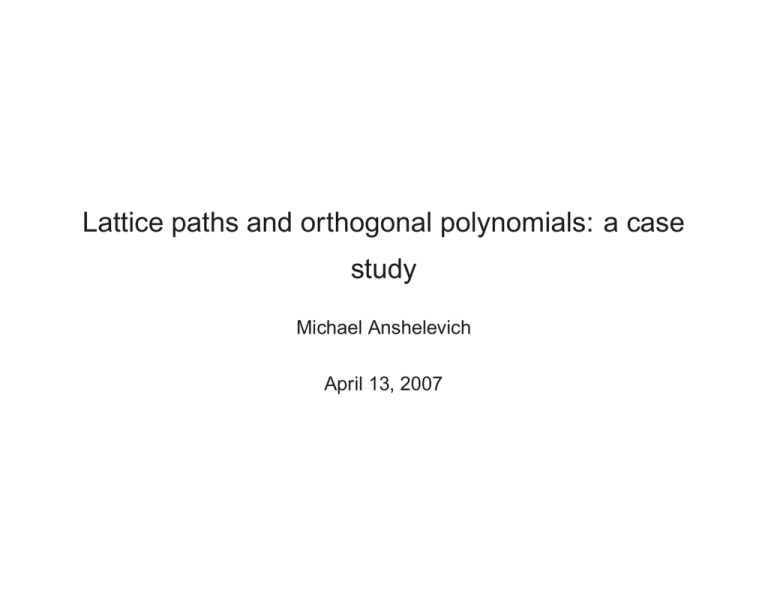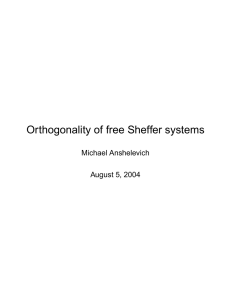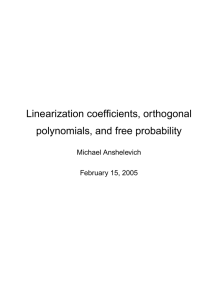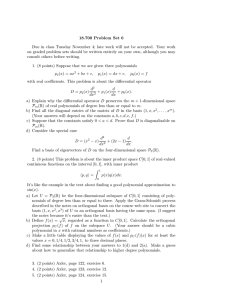Lattice paths and orthogonal polynomials: a case study Michael Anshelevich April 13, 2007
advertisement

Lattice paths and orthogonal polynomials: a case
study
Michael Anshelevich
April 13, 2007
P LAN .
• Formulation of the problem: free Meixner polynomials and their free cumulants.
• General orthogonal polynomials.
• Motzkin paths and moments.
• Modified Motzkin model for the free Meixner polynomials.
• Multivariate case: operators.
• Operators on Fock spaces.
1
F ORMULATION OF THE PROBLEM .
µt = probability measure on R, mean zero, variance t:
m1(µt) = µt(x) =
m2(µt) = µt(x2) =
Z
R
Z
R
x dµt(x) = 0,
x2 dµt(x) = t.
2
F ORMULATION OF THE PROBLEM .
µt = probability measure on R, mean zero, variance t:
m1(µt) = µt(x) =
m2(µt) = µt(x2) =
Z
R
Z
R
x dµt(x) = 0,
x2 dµt(x) = t.
{Pn} = {P0, P1, P2, . . .} = MOPS (Monic Orthogonal Polynomial System)
for µt if
Pn (x) = xn + . . .
and
hPn, Pk i =
for n 6= k.
Z
R
Pn(x)Pk (x) dµt(x) = 0
3
Definition. {Pn} are free Meixner polynomials, and µt is a free Meixner distribution, if
∞
X
1
Pn (x)z = F (z)
1 − xG(z)
n=0
n
for some F (z), G(z).
4
Definition. {Pn} are free Meixner polynomials, and µt is a free Meixner distribution, if
∞
X
1
Pn (x)z = F (z)
1 − xG(z)
n=0
n
for some F (z), G(z).
Example. Un = Chebyshev polynomials of the 2nd kind.
Orthogonal with respect to the semicircular distribution
1
dµt(x) =
4t − x2 dx.
2πt
q
0.6
0.5
0.4
0.3
0.2
0.1
–1
–0.8
–0.6
–0.4
–0.2
0
0.2
0.4
0.6
0.8
1
x
∞
X
n=0
Un(x)z n =
1
1
1
=
.
1 − xz + tz 2
1 + tz 2 1 − x tz 2 2
1+tz
5
Answer. {Pn } satisfy recursion relations
xP0 = P1,
xP1 = P2 + bP1 + t,
xPn = Pn+1 + bPn + (t + c)Pn−1
for n ≥ 2.
6
Answer. {Pn } satisfy recursion relations
xP0 = P1,
xP1 = P2 + bP1 + t,
xPn = Pn+1 + bPn + (t + c)Pn−1
for n ≥ 2.
Complete description:
q
4(t + c) − (x − b)2
1
dµt(x) =
dx + zero, one, or two atoms.
2πt 1 + (b/t)x + (c/t2)x2
7
Particular cases:
The semicircular (free Gaussian) distributions
1
4t − x2 dx.
2πt
q
The Marchenko-Pastur (free Poisson) distributions
1
2π
q
4t − (x − b)2
t + bx
dx + possibly one atom.
8
Other appearances:
Szegö (1922), Bernstein (1930), Boas & Buck (1956), Carlin & McGregor
(1957), Geronimus (1961), Allaway (1972), Askey & Ismail (1983), Cohen &
Trenholme (1984), Kato (1986), Freeman (1998), Saitoh & Yoshida (2001),
M.A. (2003), Kubo, Kuo & Namli (2006), Belinschi & Nica (2007), . . .
9
F REE PROBABILITY CONNECTION : FREE CUMULANTS.
mn(µt) = µt(xn) =
E.g. m1 = mean.
Z
R
xn dµt(x) = moments of µt.
m2 − m2
1 = variance.
10
F REE PROBABILITY CONNECTION : FREE CUMULANTS.
mn(µt) = µt(xn) =
E.g. m1 = mean.
Z
R
xn dµt(x) = moments of µt.
m2 − m2
1 = variance.
More generally, define another collection of numbers
r1, r2, r3, . . .
11
X
rn = mn −
Y
r|B|.
π non-crossing partition of n B class of π
π6=1̂
r1 = m1,
r2 = m2 − r1r1,
r3 = m3 − r2r1
= m3 −
− r1r2
−
− r2r1
−
− r1r1r1
−
.
12
X
rn = mn −
Y
r|B|.
π non-crossing partition of n B class of π
π6=1̂
r1 = m1,
r2 = m2 − r1r1,
r3 = m3 − r2r1
= m3 −
− r1r2
−
− r2r1
−
− r1r1r1
−
.
{rn} = free cumulants of µt.
13
Question. Find explicit (combinatorial) formulas for the moments and free
cumulants of the free Meixner distributions.
14
Favard’s (Stone’s) Theorem. Let {Pn} be a monic polynomial system. {Pn}
are orthogonal with respect to some measure µ if and only if they satisfy a
three-term recursion relation
xPn = Pn+1 + βnPn + γn Pn−1,
for some {βn, γn }.
15
Favard’s (Stone’s) Theorem. Let {Pn} be a monic polynomial system. {Pn}
are orthogonal with respect to some measure µ if and only if they satisfy a
three-term recursion relation
xPn = Pn+1 + βnPn + γn Pn−1,
for some {βn, γn }.
Example. Free Meixner: β0 = 0, βn = b, γ1 = t, γn = t + c.
16
Favard’s (Stone’s) Theorem. Let {Pn} be a monic polynomial system. {Pn}
are orthogonal with respect to some measure µ if and only if they satisfy a
three-term recursion relation
xPn = Pn+1 + βnPn + γn Pn−1,
for some {βn, γn }.
Example. Free Meixner: β0 = 0, βn = b, γ1 = t, γn = t + c.
Comment. Orthogonal ⇒ Recursion: nice exercise.
Recursion ⇒ Orthogonal with respect to a positive functional on polynomials:
harder.
Recursion ⇒ Orthogonal with respect to a measure: hard operator theory.
17
Use recursion to calculate moments: P0 = 1.
x = xP0 = P1 + β0P0,
m1 = µ(x) = hx, P0i = β0.
18
Use recursion to calculate moments: P0 = 1.
x = xP0 = P1 + β0P0,
m1 = µ(x) = hx, P0i = β0.
x2 = x · x = x(P1 + β0P0) = P2 + β1P1 + γ1P0 + β0P1 + β0β0P0,
m2 = x2, P0
D
E
= γ1 + β0β0.
19
Use recursion to calculate moments: P0 = 1.
x = xP0 = P1 + β0P0,
m1 = µ(x) = hx, P0i = β0.
x2 = x · x = x(P1 + β0P0) = P2 + β1P1 + γ1P0 + β0P1 + β0β0P0,
m2 = x2, P0
D
E
= γ1 + β0β0.
x3 = x · x2 = x(P2 + (β1 + β0)P1 + (γ1 + β0β0)P0)
= P3 + β2P2 + γ2P1 + (β1 + β0)P2 + β1(β1 + β0)P1 + γ1(β1 + β0)P0
+ (γ1 + β0β0)P1 + β0(γ1 + β0β0)P0,
m3 = γ1β1 + γ1β0 + β0γ1 + β0β0β0.
20
mn = coefficient of P0 in xn
21
mn = coefficient of P0 in xn
xPn = Pn+1 + βnPn + γn Pn−1.
Motzkin paths: right-to-left.
step up, weight 1.
step horizontally, on level n weight βn.
Step down, on level n weight γn .
22
Always stay above the x-axis.
xn = all paths of length n.
mn = paths ending on level zero.
23
x=
+
β0
m1 = β0.
24
x=
+
β0
m1 = β0.
β1
γ1
x2 =
+
+
β0
+
β0
β0
+
m2 = γ1 + β0β0
25
β2
γ2
β1
x3 =
+
β1
+
β1
+
β1
γ1
+
γ1
+
γ1
+
+
β0
β1
β0
+
+
β0
β0
γ1
β0
+
β0
β0
β0
+
β0
+
26
Free Meixner case: β0 = 0, βn = b, γ1 = t, γn = t + c.
No horizontal steps on level zero.
m1 = 0.
t
m2 =
= t.
b
t
= tb.
m3 =
t+c
b
b
t
t
m4 =
+
t
t
+
.
27
Free cumulants?
Motzkin paths ↔ non-crossing partitions.
28
Free cumulants?
Motzkin paths ↔ non-crossing partitions.
29
Free cumulants?
Motzkin paths ↔ non-crossing partitions.
30
Step up = beginning of class, weight 1.
Step down = end of class, weight t or t + c.
Step horizontally = middle of class.
Non-crossing partitions with no singletons.
31
Example. Semicircular: b = c = 0.
No horizontal steps = Dyck paths.
Steps down all weight t.
m2n+1 = 0,
m2n =
t2n/2
X
π non-crossing pair partition of 2n
n
= t · # {non-crossing pair partitions of 2n} = tn · n’th Catalan number.
Free cumulants: r2 = t, rn = 0,
mn =
X
Y
r|B|.
π∈NC (n) B∈π
32
Example. Free Poisson / Marchenko-Pastur: c = 0, take b = 1.
Steps down all weight t, horizontal steps weight 1.
t|π|
X
mn =
π non-crossing partition of n
For t = 1,
mn = # {non-crossing partitions of n} = n’th Catalan number.
For general t: free cumulants rn = t.
mn =
X
Y
r|B|.
π∈NC (n) B∈π
33
Free cumulants for general b, c, t?
Separate t, c: two types of steps down.
b
t+c
t+c
t+c
b
t+c
t
b
t+c
t+c
t+c
t
34
Free cumulants for general b, c, t?
Separate t, c: two types of steps down.
b
b
c
t
t
c
c
c
c
b
t
t
35
Free cumulants for general b, c, t?
Separate t, c: two types of steps down.
b
b
c
t
t
c
c
c
c
b
t
t
36
Motzkin path with colored descents → non-crossing partition.
b
b
c
t
t
c
c
c
c
b
t
t
37
Motzkin path with colored descents → non-crossing partition.
b
b
c
t
t
c
c
c
c
b
t
t
38
On each class of this partition → further non-crossing partition, one outer
class.
b
b
c
t
t
c
c
c
c
b
t
t
39
On each class of this partition → further Motzkin path, One t-descent..
c
t
b
t
b
b
c
t
c
c
c
t
40
One t-descent.
X
mn =
Y
X
.
non-crossing partitions classes of the partition Motzkin paths with one t-descent
So
rn =
X
Motzkin paths of length n
with one t-descent
=t
X
Motzkin paths of length n − 2
with only c-descents
41
Comment.
rn(µt) = t · rn(µ1).
Comment. Motzkin paths, horizontal weight b, descent weight c, no restrictions.
xPn = Pn+1 + bPn + cPn−1
(x − b)Pn = Pn+1 + cPn−1
Moments of shifted semicircular distribution, mean b, variance c.
42
M ULTIVARIATE CASE .
N ON - COMMUTATIVE POLYNOMIALS.
Rhxi = Rhx1, x2, . . . , xdi
Involution
(x1 x2 x1 x1 x3)∗ = x3 x1 x1 x2 x1.
43
N ON - COMMUTATIVE POLYNOMIALS.
Rhxi = Rhx1, x2, . . . , xdi
Involution
(x1 x2 x1 x1 x3)∗ = x3 x1 x1 x2 x1.
ϕ a state on Rhxi: linear functional, ϕ [1] = 1,
∗
ϕ P = ϕ [P ] ,
∗ ϕ P P ≥ 0.
44
Multivariate monic orthogonal polynomials
Pi(x) = xi + . . . ,
Pij (x) = xixj + . . .
n
{P~u(x)} = 1, Pi (x), Pij (x), Pijk (x), . . .
o
45
Multivariate monic orthogonal polynomials
Pi(x) = xi + . . . ,
Pij (x) = xixj + . . .
n
{P~u(x)} = 1, Pi (x), Pij (x), Pijk (x), . . .
o
Gram-Schmidt: can make orthogonal
hP~u, P~v i = ϕ P~u∗P~v = 0
unless ~
u = ~v .
46
Theorem. A family {P~u } is a MOPS for some state ϕ if and only if
xi = Pi + Bi,∅,∅,
xiPu = P(i,u) +
xiP~u = P(i,~u) +
d
X
Bi,w,uPw + δi,uCu,
w=1
X
Bi,w,~
~ uPw
~ + δi,u(1)C~
u P(u(2),u(3),...,u(k)),
|w|=|~
~
u|
with C~u ≥ 0 and, denoting ~sj = (s(j), . . . , s(k)),
Bi,~s,~u
k
Y
j=1
C~sj = Bi,~u,~s
k
Y
j=1
C~uj .
Note: can replace the whole ~
u by w,
~ but can remove only the first term of ~
u.
47
Moments:
ϕ [xi] = Bi,∅,∅,
h
i
ϕ xixj = δij Ci + Bi,∅,∅Bi,∅,∅,
h
i
ϕ xixj xk = CiBj,i,k + Bi,∅,∅δjk Cj + δij CiBk,∅,∅ + Bi,∅,∅Bj,∅,∅Bk,∅,∅.
Motzkin paths, colored, complicated.
Another approach: use operators.
48
B ACK TO ONE - DIMENSIONAL CASE .
xPn = Pn+1 + βnPn + γn Pn−1,
Vector space P of polynomials, orthogonal basis {Pn}.
Operator X of multiplication by x:
β0
1
0
X= 0
0
...
P0
γ1
β1
1
0
0
...
P1
0
γ2
β2
1
0
...
P2
0
0
γ3
β3
1
...
P3
0
0
0
γ4
β4
...
P4
...
...
...
...
...
...
P5
P0
P1
P2
P3
P4
P5
mn = µ(xn) = hP0, X n P0i .
49
More abstractly, in a Hilbert space F (C) with orthogonal basis
Ω = “vacuum vector”.
n
o
⊗2
⊗3
Ω, e, e , e , . . .
...
β0 γ1 0
0
0
...
1 β1 γ2
0
0
...
0 1 β2 γ3
0
1
β3 γ4 . . .
X= 0 0
0 0
0
1
β4 . . .
... ... ... ... ... ...
Ω e e⊗2 e⊗3 e⊗4 e⊗5
Ω
e
e⊗2
e⊗3
e⊗4
e⊗5
mn = hΩ, X nΩi .
50
In the free Meixner case,
...
0 t
0
0
0
...
1 b t+c
0
0
...
0 1
b
t+c
0
1
b
t + c ...
X= 0 0
...
0 0
0
1
b
... ... ...
...
...
...
Ω e e⊗2 e⊗3 e⊗4 e⊗5
Ω
e
e⊗2
e⊗3
e⊗4
e⊗5
X = sum of four operators:
a+ (e⊗k ) = e⊗(k+1),
B(e⊗k ) = be⊗k ,
B(Ω) = 0
a−(e⊗k ) = e⊗(k−1),
a−C(e⊗k ) = ce⊗(k−1),
a−C(e) = 0.
51
X = a+ + B + ta− + a−C,
Moreover,
D
E
+
−
−
n
n
mn = hΩ, X Ωi = Ω, (a + B + ta + a C) Ω .
E
+
−
n
rn+2 = t e, (a + B + a C) e .
D
52
Definition. A state ϕ is a free Meixner state if its monic orthogonal polynomials have a generating function
X
P~u(x)z~u = 1 +
u
~
X
i
Pi(x)zi +
X
Pij (x)zizj + . . .
i,j
= F (z) 1 −
X
i
−1
xiGi(z)
for some F (z), Gi(z).
Theorem.
h
i
D
E
ϕ xu(1)xu(2) . . . xu(n) = Ω, Xu(1) Xu(2) . . . Xu(n)Ω .
53
Here
−
−
Xk = a+
+
B
+
ta
+
a
k
k
k
kC
operators on a Fock space FC (Cd ).
B1, . . . , Bd symmetric d × d matrices.
C diagonal d2 × d2 matrix,
!
!
Bi 0
Bi 0
C=C
.
0 I
0 I
54
Moreover, the free cumulant functional
h
i
D
E
Rϕ xixu(1)xu(2) . . . xu(n)xj = t ei , Su(1)Su(2) . . . Su(n)ej ,
where
−
Sk = a+
+
B
+
a
k
k
k C.
55



